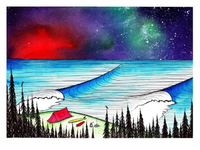He didn't go to art school. No big deal. He did have a mentor and that's all that's really necessary to learn the technical skills one needs to be a painter. Nowadays, art schools barely teach technique anyway. They're heavily focused on art historical reference and conceptual stuff (construction of deeply layered meanings, etc.). Contemporary art marches in the footsteps of Duchamp much more than the footsteps of Ingres. There's no shortage of high concept contemporary painting with crude technical execution being churned out by recent art school graduates and shown at major venues like Art Basel Miami Beach (see example below).

Much of Bob Ross's brushwork is done in a thick impasto, which is a stylistic choice that some people may regard as "crude". Monet and Van Gogh also used heavy brush strokes. Again, that's a stylistic choice, not a technical flaw. And Ross clearly could (and did) use thin applications of paint when he wanted to. Typically, his skies and bodies of water with reflections in them were done with a thin paint application.
I think the big source of confusion is that Bob Ross, like Thomas Kinkade, painted a lot of very conventional, banal subject matter. As landscape painters go, he's no J.M.W. Turner or Marcus Larson, but it's also incorrect to say he was unskilled.















